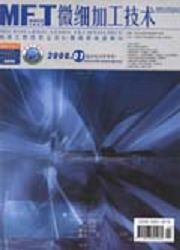

 中文摘要:
中文摘要:
为了分析超疏水表面的物理特性及应用前景,介绍了粗糙超疏水表面的两种理论模型,提出了一种基于MEMS加工技术的超疏水表面制备工艺,即利用ICP刻蚀工艺制备规则的硅方柱,并用旋转涂覆TeflonR AF1600作为疏水薄膜,制备了疏水特性可控的硅表面.对接触角进行了测量,结果表明,在平整Teflon薄膜表面上,去离子水液滴的本征接触角约为117 °,在边长间距比为10 μm/35 μm的方柱表面上的去离子水液滴显现接触角可达170 °.另处,还给出了为避免Wenzel液滴出现的'安全'设计参数(方柱间距边长比小于2.5),以及一种基于润湿性梯度的微流体操控方案.
 英文摘要:
英文摘要:
For analyses of physical characteristics and applications of the super-hydrophobic surfaces, two theoretical models of droplets on a rough hydrophobic. surface were introduced and a technique of the super-hydrophobic surfaces based on MEMS technology was proposed, i.e., an array of silicon pillars was obtained by ICP etching and Teflon [registered trademark] AF1600 was rotationally coated on the silicon pillar surfaces as the hydrophobic layer to obtain the hydrophobic-controllable surfaces. The results of the contact angles measured indicate that the equilibrium contact angle of deionized water on the flat Teflon [registered trademark] AF1600 film is about 117° and the apparent contact angle of deionized water on the super-hydrophobic pillars with a length-to-space ratio of 10/35 is about 170°. Additionally, some parameters for safe design (the length-to-spacer ratio is less than 2.5) were given to avoid appearance of the Wenzel droplets and a manipulation project for controlling microfluidics was proposed by wet gradient.
 同期刊论文项目
同期刊论文项目
 同项目期刊论文
同项目期刊论文
 期刊信息
期刊信息
